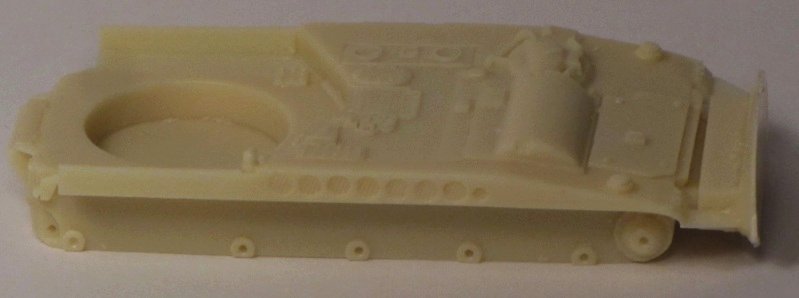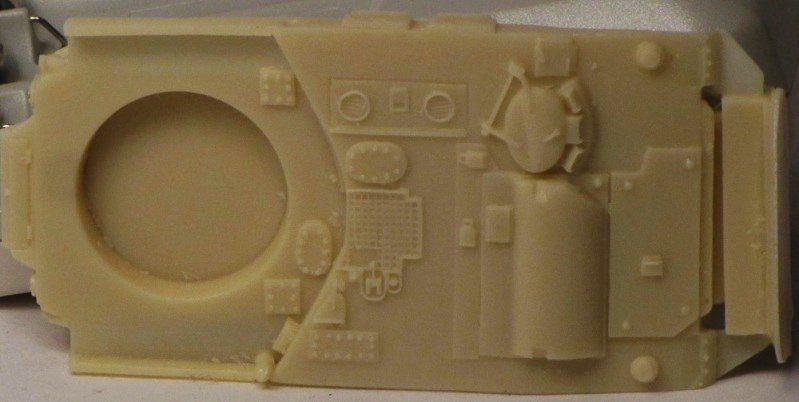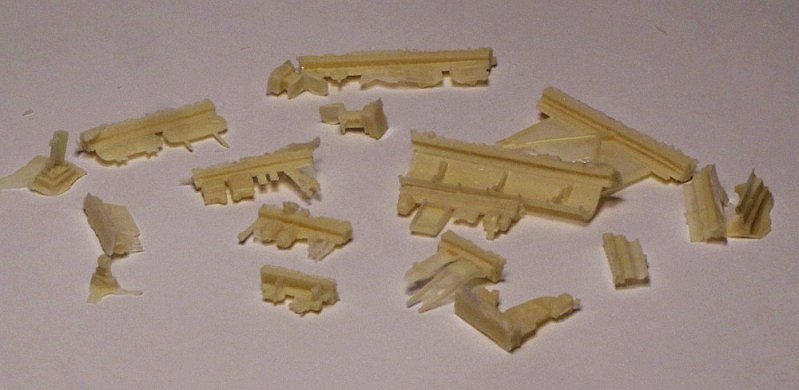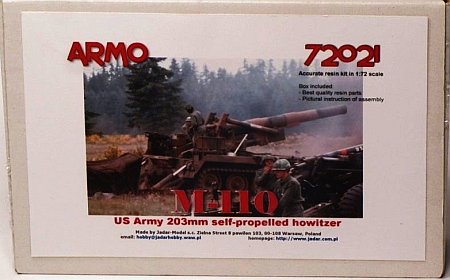|
Note that ARMO released 2 versions of the M110 - the M110 (kit 72021)
and M110A2 (kit 72022). As far as I can tell, all the parts to build
the M110A2 are included in my M110 kit. The M110 and M107 were the
standard US heavy self-propelled guns of the Vietnam era. Both
vehicles, along with the M578 light recovery vehicle, shared a common
hull. In fact the 175 mm gun of the M107 and 8 inch howitzer of the
M110 were interchangable on the M158 mount, so a particular vehicle
could be both an M107 and an M110 at different points in its life. The
M110 featured a stubby 25.3 caliber M2A2 8 inch howitzer, with no muzzle
brake, while the M110A1 had a longer 39.5 caliber M201 howitzer. The
M110A2 added a double baffle muzzle brake to the M110A1 barrel
(redesignated M201A1)

The kit is packaged in a sturdy box with a colour photo of a MERDC
camouflaged M110 in action. Inside, there are 90-odd parts cast in a
cream coloured resin, packed in a single zip-closed bag. Despite some
very fragile parts, there was very little breakage. This is the second
ARMO kit that I bought, and while the resin casting is good, it is not
as nice as some of their later kits. Instructions comprise a single A4
sheet, with a series of exploded views. Having access to the
instruction sheet for the Italeri 1/35 kit would be useful for fitting
some of the small details. No decals are provided.

The largest part is a one-piece hull. The hull is attached to its
moulding stub along the front edge, so minimal detail is lost, and
removing the excess resin should be easy. The driver's hatch is moulded
shut. The pioneer tools are moulded in place on the rear tool rack,
though this detail is largely hidden by the rear spade. The detail on
the hull matches nicely with Italeri's 1/35th scale kit.

Unfortunately, the hull sides are not straight and parallel to one
another. The hull is about 2 mm wider at its midpoint than at the rear,
though I believe this can be corrected by rebuilding the rear sections
of the fenders and hull sides, which are very simple in shape. Also,
the 8 circular intakes on the right side of the hull are not quite
perfectly aligned.

The cannon assembly is very well detailed. The howitzer itself is
composed on a two sections, one from the breech block to the forwardmost
reinforcing ring, and then the forward section of the barrel. This
allows ARMO to offer the M2A2 an M201A1 barrels as options, and both are
included in my kit. In fact, you could also model the M201 barrel by
removing the muzzle brake from the M201A1. The M2A2 barrel is moulded
with an open muzzle, while the muzzle brake on the M201A1 is moulded
solid. The rear section of the barrel is not completely straight, with a
kink in the barrel just ahead of the breech. The gun mount is
comprised on 26 parts, and included plenty of detail. A nice touch is
the inclusion of four 8-inch projectiles.

The suspension detail is the biggest let down in my eyes. The
road wheels feature a very thin rim, whereas the real rubber-tired wheels
have a much thicker rim. The tracks are provided 10 sections, all of
which are somewhat banana-shaped. The track detail is OK, but trying to
straighten out the tracks and get them wrapped around the wheels will
be a challenge.

Remaining details include the rear spade assembly, rear fenders, hull
stowage and seating, and front headlights with delicate brush guards.
Without building the kit, it's tough to assess the dimensional accuracy.
I have no drawings of this vehicle. However, comparing key dimensions
from my reference, I found the kit scales out quite well. The width
(measured at the widest part of the hull) is within 1 scale inch of the
prototype. The wheels scale out to within 1 scale inch in diameter and
are almost spot on in width. The tracks are a little too wide (20 scale
inches) and are noticeably too long in pitch (close to 10 scale inches,
vs. 6 inches in reality). The M2A2 barrel scales out to just over 3
scale inches too long, while the big M201A1 barrel comes out more than
30 scale inches too long.
Overall, the kit is quite complete, and well done. I think I may cut
apart the tracks into individual links, to try to reduce the pitch and
straighten the lengths, and I'll look at adding strips of plastic to
thicken the wheel rims. If I'm feeling really ambitious, I might even
try to create the massive M113 175 mm gun (60 calibers long - nearly six
inches in scale) and convert the model to an M107!
References:
[1] Sheridan: a History of the American Light Tank by R. P. Hunnicutt
Review sample purchased by the author.
|
